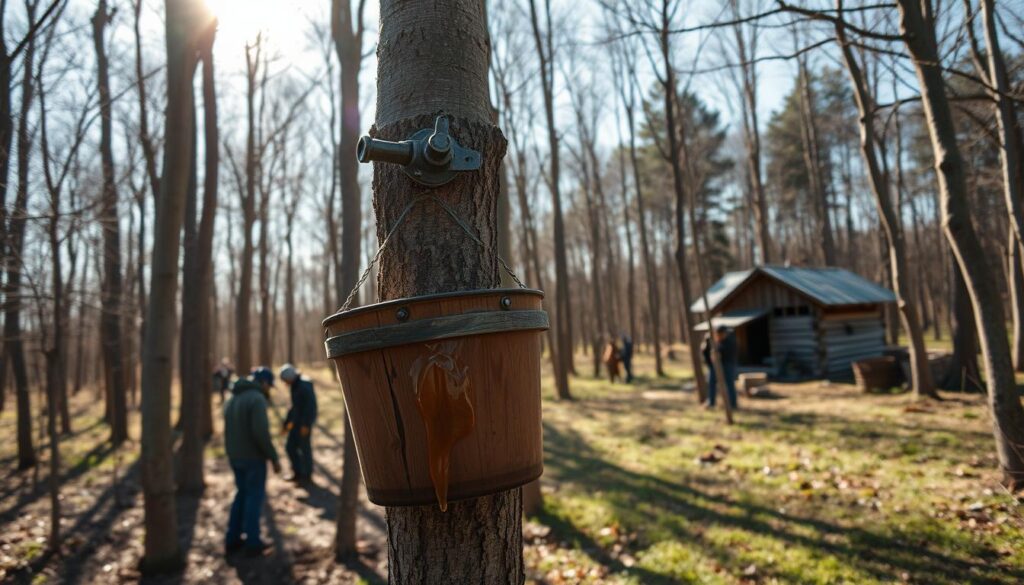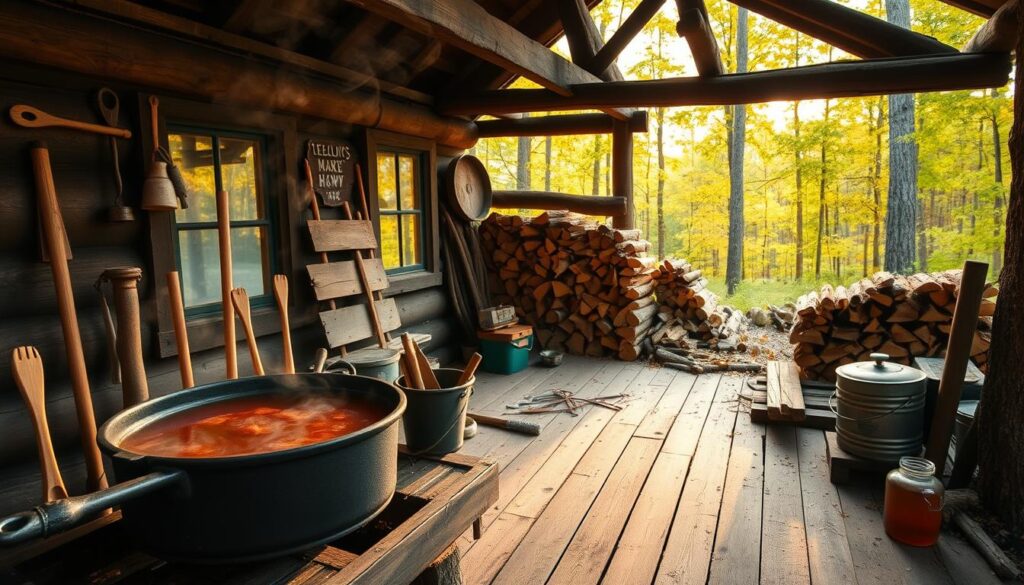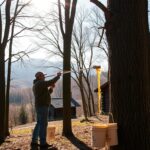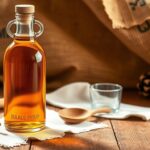Maple syrup is a treasure in North American tradition. It turns simple tree sap into a golden, sweet treat. This process captures the essence of seasonal change and craftsmanship.
Sugarmakers have mastered traditional syrup making over generations. They mix old techniques with new technology. Their work starts in late winter and early spring when maple trees wake up.
This journey from tree to table needs precise timing and special equipment. Skilled producers tap maple trees to collect sap. This sap is then boiled and reduced to create the rich, amber syrup we love.
Maple syrup production is more than just making food. It’s a cultural practice that connects communities to nature. It celebrates the balance between human actions and nature’s cycles.
Readers will learn about the steps to make this beloved natural sweetener. They’ll see how tree selection, tapping, and scientific processes turn raw sap into pure maple syrup.
Understanding the Traditional Art of Maple Syrup Production
Maple syrup production is a mix of culture and skill. It tells a story of tradition and connection across generations. This sweet practice is deeply rooted in North America.
History of Maple Syrup Making in North America
Maple syrup has a long history, even before European settlers came. Native American tribes first found out how to make maple syrup. Their methods are the base of today’s maple syrup making.
- Indigenous tribes saw maple trees as valuable
- They used wooden tools and simple ways to collect sap
- They passed on sap extraction knowledge for years
Indigenous Peoples’ Connection to Maple Harvesting
Native communities saw maple trees as sacred. They had special rituals and ways to collect sap. The maple tree was not just a source of food, but a spiritual connection to the natural world.
“Maple sap is the lifeblood of the forest, given to us by the Creator to nourish and sustain our people.” – Traditional Indigenous Teaching
Evolution of Syrup Making Techniques
Methods for making syrup have changed a lot over time. From simple bark containers to modern vacuum systems, the process has gotten more advanced.
- Early wooden bucket collection systems
- Introduction of metal taps and containers
- Development of large-scale commercial processing techniques
- Advanced technological interventions in sap extraction
Identifying the Right Maple Trees for Tapping
Tapping maple trees is an art that starts with picking the right trees for sap. Not all maple trees are good for making syrup. The sugar maple (Acer saccharum) is the best choice for syrup.
To find the right maple trees for tapping, sugarmakers look at a few key things:
- Tree Age: Mature trees between 40-100 years old are ideal
- Diameter Requirements: Trees should be at least 10 inches in diameter
- Tree Health: Robust, disease-free trees with healthy bark
Different maple species have different sap yields. While sugar maples are the top choice, other varieties can also be tapped:
| Maple Species | Sap Sugar Content | Tapping Suitability |
|---|---|---|
| Sugar Maple | 2-3% | Excellent |
| Red Maple | 1-2% | Good |
| Black Maple | 2-3% | Very Good |
It’s important to tap trees in a way that keeps the forest healthy. Experienced sugarmakers follow strict rules to protect trees. They don’t tap too many trees and let them rest between seasons.
Knowing about tree characteristics is key to making great maple syrup. By choosing and caring for maple trees wisely, producers make high-quality syrup and help keep the forest healthy.
Essential Equipment for Maple Sap Collection
Collecting maple sap needs special tools that make the old ways better. Today’s sugarmakers use the latest gear to make syrup better and faster.
Getting maple sap right starts with the right equipment. Sugarmakers use special tools to get and process sap well.
Modern Tapping Tools and Supplies
The first step in getting maple sap is using the right tools. Here are some key ones:
- Battery-powered drill with special maple tapping bits
- Stainless steel spiles in different sizes
- Plastic tubing for easy sap collection
- Tools that don’t hurt the tree
Storage and Collection Systems
New systems have made getting sap better. Sugarmakers now use:
- Vacuum-assisted pipeline networks
- Big stainless steel tanks for sap
- Insulated containers to keep sap good
- Systems to filter sap first
Maintenance Requirements for Equipment
Keeping equipment in good shape is key. Cleaning, sanitizing, and checking tools and systems often is important for great syrup.
Professional sugarmakers know good equipment means better syrup.
The Maple Syrup Harvesting Process: Step-by-Step Guide
The maple syrup harvesting process is a delicate dance of timing, technique, and natural conditions. Sugarmakers carefully navigate each stage of maple sap collection to transform tree sap into liquid gold. Understanding the intricacies of this process helps us appreciate the skill behind it.

- Tree Selection and Preparation
- Identify mature maple trees (at least 10 inches in diameter)
- Check tree health and bark condition
- Plan tapping locations carefully
- Tapping Techniques
- Drill precise holes at correct angle
- Insert clean spiles or taps
- Ensure minimal tree damage
- Sap Collection Methods
- Use traditional bucket systems
- Implement modern vacuum pipeline networks
- Monitor sap flow regularly
The maple sap collection requires careful monitoring of weather conditions. Ideal harvesting happens during specific temperature ranges – typically between 40°F and 50°F with nighttime temperatures below freezing.
| Stage | Key Considerations | Duration |
|---|---|---|
| Tree Preparation | Assess tree health, mark tapping locations | 1-2 days |
| Sap Extraction | Collect raw sap using buckets or vacuum systems | 4-6 weeks |
| Initial Processing | Transport sap to sugar house | Continuous during harvest |
Professional sugarmakers understand that each step in the maple syrup harvesting process impacts the final product’s quality. Precision, patience, and respect for natural rhythms define successful maple sap collection.
Optimal Weather Conditions for Sap Flow
The maple syrup harvesting process relies heavily on the right weather. Nature sets up a precise temperature dance that’s key to sap collection success. Sugarmakers watch the weather closely to get the most from their season.
For sap collection to work, a certain temperature range is needed. This range creates pressure in the trees. The best conditions are cold nights and warm days, with temperatures above 40°F (4°C).
Temperature Requirements for Optimal Sap Flow
The temperature change inside the tree is what drives sap flow. At night, the cold makes the tree cells contract, creating a vacuum. Then, when it warms up, the pressure changes, pushing the sap out.
- Nighttime temperatures: 20-32°F (-6 to 0°C)
- Daytime temperatures: 40-50°F (4-10°C)
- Ideal temperature swing: 40-50°F difference between night and day
Seasonal Timing Considerations
The sap collection season usually lasts 4-6 weeks in late winter and early spring. The exact timing can vary by region, making local climate knowledge essential for success.
| Region | Typical Sap Season Start | Typical Sap Season Duration |
|---|---|---|
| Northeast US | Late February | 4-6 weeks |
| Midwest US | Early March | 3-5 weeks |
| Canadian Provinces | Mid-March | 4-6 weeks |
Climate Impact on Sap Production
Climate change is a big challenge for sap collection. Unpredictable weather messes up the traditional harvesting times. Warmer winters and shorter cold snaps can cut down syrup production a lot.
Knowing these weather details helps sugarmakers adjust their methods. This way, they can improve their sap collection and syrup making.
Proper Tree Tapping Techniques

Tapping maple trees is a delicate art that needs precision and care. The maple syrup harvesting process starts with picking the right trees and using the right tapping techniques. Mature sugar maple trees, 40-60 years old and at least 10 inches wide, are best for sap collection.
“The success of maple syrup production depends on careful and thoughtful tree tapping,” says traditional sugarmakers.
There are a few key things to consider when tapping maple trees:
- Tree diameter determines the number of taps
- Proper hole depth ranges between 1.5 to 2 inches
- Drilling angle should be slightly upward to facilitate sap flow
- Maintain a consistent distance between tap holes
When starting the maple syrup harvesting process, sugarmakers must pick tap locations carefully. They look for areas with smooth bark and avoid spots where taps were placed before to prevent damage.
| Tree Diameter | Maximum Taps Allowed | Recommended Tap Depth |
|---|---|---|
| 10-15 inches | 1 tap | 1.5 inches |
| 16-20 inches | 2 taps | 2 inches |
| 21+ inches | 3 taps | 2 inches |
Using the right tapping techniques helps protect the tree and increases sap production. Sugarmakers move tap locations every year. This lets trees heal and stay productive for many years in the maple syrup harvesting process.
Modern Sap Collection Methods and Systems
The maple syrup industry has changed a lot with new sap collection technologies. Now, sugarmakers use advanced systems that make harvesting more efficient and increase yields.
New methods in maple sap collection have changed old ways of harvesting. The use of modern sugar house equipment has made the process better and more productive.
Vacuum Systems and Pipeline Networks
Vacuum technology has really changed maple sap collection. These systems use negative pressure to get more sap from maple trees.
- Increases sap yield by 50-80%
- Reduces manual labor
- Minimizes tree damage during collection
- Enables faster sap extraction
Collection Tank Management
Managing collection tanks well is key to keeping sap quality up. Stainless steel tanks with precise temperature control keep the sap fresh.
| Tank Feature | Purpose |
|---|---|
| Stainless Steel Construction | Prevents contamination |
| Refrigeration Capability | Preserves sap freshness |
| Sanitization Systems | Maintains hygienic conditions |
Monitoring Sap Flow
Now, advanced electronic systems track sap flow in real-time. Digital sensors give sugarmakers quick info on collection rates, tree health, and weather.
“Technology has transformed maple sap collection from an art to a precise science.” – Vermont Maple Association
These new methods show how technology improves traditional maple syrup making. They keep the craft’s true spirit alive.
Sugar House Operations and Equipment

The sugar house is where maple sap turns into syrup. Special equipment is key in this process. It uses precise techniques to make the sap into syrup.
Today’s sugar houses have advanced tools for better efficiency and quality. The main piece is the evaporator. It heats the sap to concentrate it.
- Primary sugar house equipment includes large stainless steel evaporators
- Advanced filtering systems remove impurities during syrup production
- Temperature-controlled bottling stations ensure consistent product quality
Boiling sap needs careful attention. Sugarmakers watch the temperature, density, and sugar levels. They aim to make one gallon of syrup from 40 gallons of sap.
Cleanliness and a smooth process are vital. Stainless steel and strict cleaning rules help make safe syrup. The right temperature is also important.
“The sugar house is where science meets tradition in maple syrup making” – Vermont Maple Sugar Makers Association
Professional sugarmakers spend a lot on top-notch equipment. This ensures they make syrup consistently and of high quality.
The Science Behind Sap to Syrup Conversion
The Maple Syrup Harvesting Process turns tree sap into a golden, sweet treat. It’s a journey filled with science and skill. Sap boiling techniques are key to changing raw sap into syrup.
Maple sap changes a lot during this process. It goes from a weak sugar mix to a thick, tasty syrup. This change happens through complex molecular changes.
Chemical Composition Dynamics
The journey of maple syrup production has many stages:
- Sugar concentration goes up from 2% to about 66-67%
- Water content drops a lot during boiling
- Flavor compounds form through Maillard reactions
- Natural sugars caramelize, adding maple’s unique taste
Precise Density Measurements
Sugarmakers use special tools to track syrup’s progress. Hydrometers are key in finding when sap turns into maple syrup.
Rigorous Quality Control
Quality is a big deal in sap boiling. Producers check many things to make sure the syrup is top-notch:
- They check color for consistency
- Verify clarity
- Examine flavor
- Check sugar concentration
The Maple Syrup Harvesting Process is a mix of science and tradition. It turns natural sap into a delicious treat.
Sustainable Practices in Maple Syrup Production
The maple syrup industry is now focused on sustainable production. This is to keep both the environment and the economy healthy. Modern sugarmakers are using new green practices to protect forests and lessen environmental harm.
Sustainable maple syrup production includes several important steps:
- Using renewable energy in sugar houses
- Creating water recycling systems
- Managing forests responsibly
- Keeping maple trees healthy with careful tapping
Forest conservation is key in the Maple Syrup Harvesting Process. Today, producers use advanced methods to reduce tree stress and keep groves productive. Selective tapping, rotation methods, and careful tree monitoring help maple forests stay healthy for the future.
“Sustainability is not just an environmental choice, but an economic necessity for maple syrup producers.” – Vermont Maple Sugar Makers Association
Economic sustainability goes hand in hand with environmental practices. Maple syrup producers are mixing old ways with new tech to make their operations more efficient and strong. This supports both the environment and the economy.
New monitoring tools let sugarmakers track forest health and sap production with great accuracy. These tools help improve sustainable practices while keeping the traditional maple syrup craft alive.
Understanding Maple Syrup Grades and Classifications
The maple syrup grading system is key to the Maple Syrup Harvesting Process. It gives consumers insight into the quality and taste of maple syrup. Sugarmakers classify syrup by color, flavor, and quality, ensuring each bottle meets standards.
Maple syrup classification is more than just categorizing. It tells a story of flavor, terroir, and craftsmanship. This speaks to the world of maple production.
Color Standards: A Visual Guide
The color of maple syrup tells us about its flavor and when it was harvested. Maple syrup grades include:
- Golden Color (Delicate Taste): Lightest grade, harvested early in the season
- Amber Color (Rich Taste): Slightly darker, with more pronounced maple flavor
- Dark Color (Robust Taste): Deep amber, intense maple characteristics
- Very Dark Color (Strong Taste): Deepest color, most intense flavor profile
Flavor Profiles Explained
Each maple syrup grade has a unique taste. The flavor is shaped by several factors during the harvesting process. These include:
- Tree age
- Seasonal timing
- Weather conditions
- Sap collection methods
Commercial Grading Systems
| Grade | Color | Flavor Intensity | Harvest Timing |
|---|---|---|---|
| Golden | Very Light | Delicate | Early Season |
| Amber | Light Amber | Rich | Mid Season |
| Dark | Dark Amber | Robust | Late Season |
| Very Dark | Darkest | Strong | End of Season |
The maple syrup grading system is a testament to the artistry and precision of traditional maple syrup production.
Knowing these classifications helps us appreciate the complexity and craftsmanship of maple syrup. It turns a simple sweetener into a rich culinary experience.
Common Challenges and Troubleshooting
Maple syrup harvesting comes with its own set of challenges. Sugarmakers need to be skilled and adaptable to overcome these hurdles. They use traditional methods to make high-quality syrup.
Experienced producers face several key challenges during maple syrup production:
- Unexpected temperature changes that affect sap flow
- Equipment failures in tapping and collection systems
- Risks of bacterial contamination
- Unpredictable syrup color and flavor
Weather is a big factor in maple syrup harvesting. Quick changes in temperature can impact sap production. Producers must stay alert and flexible.
| Challenge | Potential Solution |
|---|---|
| Inconsistent Sap Flow | Monitor daily temperature patterns |
| Equipment Failure | Regular maintenance and backup systems |
| Contamination | Sterilize equipment between uses |
Technical know-how is key to solving these problems. Traditional syrup making methods paired with modern tech help keep syrup quality high.
Professional maple syrup makers spend a lot of time learning about these issues. They develop strong troubleshooting plans. This ensures their syrup is top-notch.
Conclusion
The Maple Syrup Harvesting Process is a mix of old traditions and new tech. It shows how people have always been clever and cared for nature. From the first days of Indigenous communities to today’s advanced farming, syrup making is a story of human creativity and respect for the earth.
Old ways of making syrup are key to keeping maple’s cultural roots alive. Sugarmakers in North America mix old wisdom with new tech. This way, every drop of maple syrup is a taste of sustainable farming. It’s a journey that turns simple sap into a sweet treasure that links people and places.
Learning about maple syrup production is more than just a cooking skill. It shows a strong bond between people and nature. Choosing the right maple trees, tapping them carefully, and processing the sap takes a lot of skill. It turns raw sap into a treasured natural product that shows off farming know-how and care for the environment.
When we dive into the world of maple syrup, we learn to value the amazing work behind it. The growth of maple syrup production shows how old traditions can stay strong in today’s farming world. It keeps cultural heritage and nature’s balance alive.



